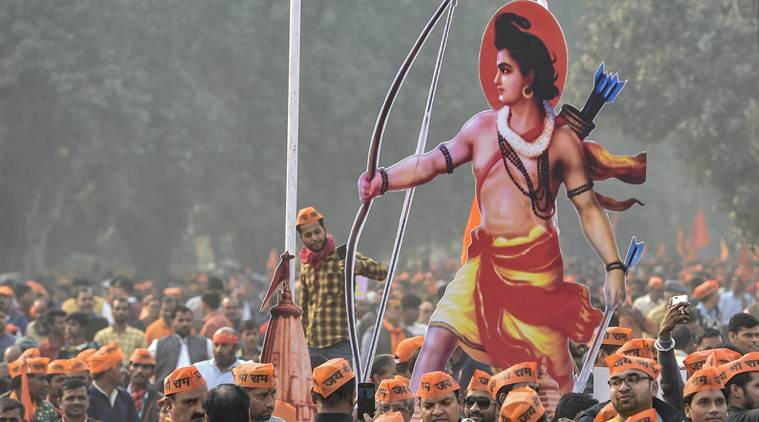Over the last several days, the Vishva Hindu Parishad (VHP), the RSS, a few prominent BJP leaders and religious figures have been demanding a law that would allow construction of a Ram temple in Ayodhya. After VHP and RSS leaders raised the demand at a rally in Delhi on December 9, the VHP and others have continued to pitch for such a law. At a time when the Ayodhya title suit hearing is pending resumption in the Supreme Court, a look at the government’s legal options and the possible fallout:

In September, days before he retired, then Chief Justice of India Dipak Misra set the stage for resumption of hearing on the title suit over the site in Ayodhya. Rejecting the plea to refer to a larger Bench its 1994 ruling, in which it observed that “a mosque is not an essential part of the practice of the religion of Islam and namaz by Muslims can be offered anywhere, even in open”, the three-judge Bench ruled that it would start hearing appeals in the week starting October 29. Groups that have been demanding construction of a temple perceived this as fast-tracking of the case. However, after Justice Ranjan Gogoi took over as the new CJI, he did not give in to the Uttar Pradesh government’s plea for an early hearing, and ordered the listing of these appeals in the first week of January. This has led to the clamour from various quarters for a law that would allow building a Ram temple in Ayodhya.
If the government plans to attempt bringing a law or an ordinance on this, how can it go about doing so?
The decision will be at the political discretion of the central government. If it does plan to bring a law, it would be as an ordinary Bill that would require a simple majority in both Houses. It remains to be seen whether such a law, if brought, would provide for a temple on the disputed land, or in the vicinity of the demolished mosque. The Supreme Court has, however, already laid down that any move towards abatement of pending suits would be unconstitutional. Following the demolition of Babri Masjid, the Congress-led government had passed the Acquisition of Certain Area at Ayodhya Act, 1993, allowing it to acquire the land surrounding Babri Masjid, even as the Allahabad High Court was hearing a clutch of petitions on the disputed land. When it was challenged in the Supreme Court, a five-judge Bench upheld the Act but the majority verdict struck down Section 4(3) that provided for abatement of pending suits and legal proceedings without an alternative dispute resolution mechanism.
Can the Supreme Court intervene in a move that is essentially intended to supersede ongoing legal proceedings?
The Seventh Schedule of the Constitution lists 100 items on which Parliament has the exclusive right to legislate; additionally, Parliament can legislate on 52 items under the Concurrent List. From a reading of the two lists, Parliament has complete authority to legislate on matters relating to “acquisition and requisitioning of property”. But can Parliament introduce a law to build a temple on disputed land? There is no bar — the Seventh Schedule makes it clear that Parliament can legislate on “any other matter not enumerated” in List II (State List) or List III (Concurrent List). And Parliament can frame a law even if the matter is pending in court. However, the Constitution allows the judiciary to adjudicate upon the constitutional validity of all laws.
Story continues below this ad
Is there any precedent of such executive or legislative action — by means of an ordinance or a law — in a matter similar to this one?
There have been instances when the government has introduced ordinances, later ratified by Parliament, on matters that were sub judice. For instance, Parliament passed a Bill in August this year to overturn a Supreme Court order concerning safeguards against arrest under the SC & ST (Prevention of Atrocities) Act. The ordinance was introduced even as the court was hearing a review petition filed against the order. Another example is the Acquisition of Certain Area at Ayodhya Ordinance, 1993; the Act was effectively rendered inactive in 2010 when the Allahabad High Court delivered its verdict on the title suit dividing 2.77 acres land among three parties.
Is this a question of the primacy of legislature over judiciary?
One the one hand, the government has wide powers to frame a law including building a temple on disputed land. On the other, the Supreme Court has the power to review whether the law is legal under the Constitution.
Story continues below this ad
In a case like this, legislation clearing the way for a temple would favour one party over another in the dispute. The judiciary has asserted earlier that this cannot be resorted to in a case between two parties. One of the clearest such judicial assertions was made by a Constitution Bench on a presidential reference made in 1991 by then President R Venkataraman, over a matter concerning the Cauvery Water Disputes Tribunal. “The principle which emerges from these authorities is that the legislature can change the basis on which a decision is given by the Court and thus change the law in general which will affect a class of persons and events at large. It cannot, however, set aside an individual decision interparties and affect their rights and liabilities alone,” said a five-judge Bench headed by then CJI Ranganath Misra. The Bench had added that “such an act on the part of the legislature amounts to exercising the judicial power of the State and to functioning as an appellate court or Tribunal” — which is not allowed under the constitutional division of powers.

 During the December 9 VHP-led rally in Delhi, where speakers said legislation for a temple was the only option. (PTI)
During the December 9 VHP-led rally in Delhi, where speakers said legislation for a temple was the only option. (PTI)





































